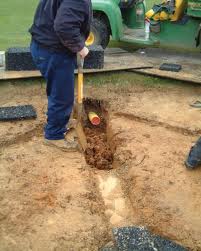





A water meadow is an area that is kept constantly moist by the close proximity of a river, rather than a pond, and often becomes a flood plain or wash during the winter, being periodically inundated as the river rises. Obviously, in a garden, this situation would not be desirable and, in any event, would be difficult to arrange. However, it is still possible to create the impression of a water meadow by careful planting and preparation of the soil. A water meadow should be planned as an extension to a water feature that is intended to appear natural, being a lush grassy area that is home to colonies of interesting moisture loving plants, which enjoy such conditions rather than the clinical manicured cleanliness of the formal bog garden.
In many respects, a water meadow is very similar to an alpine meadow. However, alpine meadows recreated in gardens are normally only reliably damp during the spring, often becoming quite dry in the warmer summer months. With a water meadow this must not be permitted to happen; constant moisture is the key to success.
In nature, a water meadow consists largely of silt, which is continually deposited by flooding, yet it drains freely after inundation. It also has a relatively heavy covering of grass. Therefore, the soil excavated when creating a pool or stream is unlikely to be suitable for spreading around the feature if a water meadow is contemplated. Heavy clay soil or any soil containing a large proportion of stones should be disposed of elsewhere. Good average garden soil, particularly a medium loam, is a much better proposition. Indeed, any garden soil that is neither extremely light nor heavy can be prepared to allow the successful establishment of water meadow plants. However, the first requirement is good drainage, which can be achieved by laying a system of pipes below ground.
 The drainage system should be installed at least 45cm (18in) below the surface of the soil. This will allow water to percolate through the soil and into the pipes, rather than rush away freely and create rapidly drying surface conditions. The prevention of standing water for any lengthy period is the main requirement.
The drainage system should be installed at least 45cm (18in) below the surface of the soil. This will allow water to percolate through the soil and into the pipes, rather than rush away freely and create rapidly drying surface conditions. The prevention of standing water for any lengthy period is the main requirement.
Any standard land drainage pipes are suitable. They should be installed in a simple herring-bone pattern that leads with a gentle fall to either a main drain or ditch. If neither is available, the water can be directed into a soakaway. For the most part, a soakaway filled with broken bricks will adequately remove excess water.
Once the drainage system is in place, the soil should be prepared by digging in plenty of well rotted garden compost or similar organic material. Remember that a genuine water meadow is likely to be rich in both nutrients and organic material owing to regular winter flooding The plants that prosper under such conditions demand much richer soil than one might suppose, especially since they will be competing with vigorous grasses.
The soil preparation should be sufficiently thorough that it can be raked out smoothly, allowing grass seed to be sown. Although water meadow plant seed mixtures are available, sometimes incorporated with an appropriate grass mixture, it is much more satisfactory to establish the grass first, then plant the water meadow plants through it. For the best effect, use a fine-leaved grass such as fescue. While this is not a species that would tolerate the kind of inundation to which a natural water meadow might be subjected, it will provide a satisfactory background for water meadow plants and permit them to prosper with minimal competition.
Once the soil has been raked out, firm it down by shuffling across the area with your feet, then rake out the surface again. While it need not be level from one end to the other, it should be free from unnecessary undulations. Mark out the area to be sown in metre or yard squares, depending on the coverage specified on the seed packet. You can either use the edge of a hoe to mark a grid in the freshly prepared tilth, or stretch strings between pegs set around the edge of the site. Measure out the required amount of grass seed for each square in a cup and spread this evenly over the soil. Gently rake over to provide a smooth finish.
Germination will take place within a week or ten days, depending upon the weather. It is best to sow the grass in spring or autumn when the weather is not too cold and the soil moisture content is good. While you can sow grass seed during the summer, regular watering will be essential if it is to grow away strongly.
Any weeds that appear among the grass seedlings should be removed by hand, as at present there is no satisfactory selective weedkiller that can be used freely on seedling grass. Once the turf has knitted together, it is vital to spray it with a selective broad-leaf weedkiller. This will kill all potential competition before your chosen water meadow plants are introduced. Once the latter have been planted, it will be almost impossible to spray, as most of the desirable water meadow plants are broad-leaved types.
Having ensured a clean established turf, you can then plant the water meadow species. These are best raised in plugs and planted out with a small rootball. Establishing the grass in spring and allowing it to come through the summer is ideal, as the flowering water meadow plants can be planted during the autumn and will become well established by the following spring and summer flowering season.
Copyright © www.100flowers.win Botanic Garden All Rights Reserved